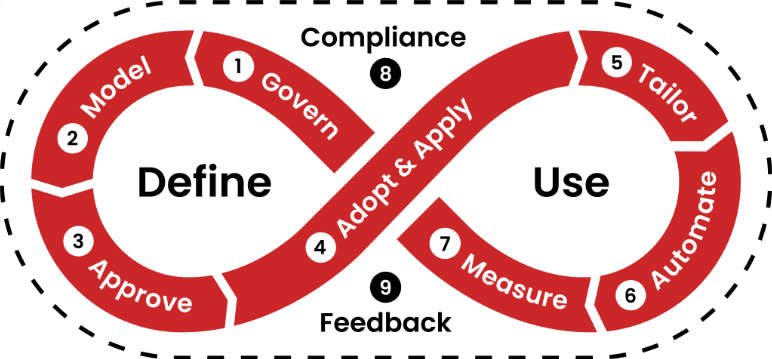
There are fundamental differences between transactional business processes, such as order processing, and engineering processes, such as product or software development, which are widely characterized as knowledge-centric work.
The idea-to-offering value stream of a product or service is characterized by many iterations, feedback loops, cross-discipline synchronizations and even increased tool automation, but the process is still driven by humans. Furthermore, development of software-intensive products continues beyond Start of Production (SOP) and extends into actual end-of-life (EOL) many years later.

A Model-based approach for engineering processes
While some organizations describe their engineering processes in documents, other leading engineering companies have transitioned to a model-based process landscape optimized for knowledge-centric work.
This approach has been realized using Stages in automotive, aerospace, medical device, transportation and other engineering-driven industries.
Explore the unique Stages features optimized for engineering processes along the whole process lifecycle.

Govern
Effective governance is essential for successful process rollouts:
- Identify stakeholders and key business objectives.
- Elicit value streams.
- Define process architecture and process owners.

Model
Create process models instead of static pictures:
- Model human-friendly processes structured by a WHO-WHAT-WHEN-HOW-WHY process-metamodel.
- Safely build large process landscapes, variants and tailored instances through modular process architecture with clearly defined interfaces.
- Improve process consistency by automatically validating modeling guidelines.

Approve
Ensure stakeholders align on process changes:
- Define customized review and approval workflows.
- Capture stakeholder feedback through decision methods such as ballots or full consensus.
- Minimize effort by automating process updates, version and status management.


Adopt & Apply
Adopt new practices, methods and tools quickly:
- User-centric display of process flows, SIPOC tables, RASIC and other human-friendly visualizations
- Full transparency from top-level value streams to detailed process activities.
- Annotated changes in case of process updates.

Tailor
Only do what matters with rules-based process tailoring:
- Calculate the optimal process for each program, project or team.
- Adjust processes without changing the past.
- Signal potential compliance violations.

Automate
Maximize process efficiency through integrations with Atlassian Jira, IBM Engineering Lifecyle Management, PTC Codebeamer and Integrity, MS SharePoint, MS Project, and other engineering tools.

Measure
Understand how processes are used in practice:
- Gain insights from live usage statistics.
- Derive KPIs via customizable reports.

Compliance
Reduce risk of non-compliance by mapping regulatory and industry standard requirements onto your processes:
- Detect compliance gaps by maintaining traceability to standards.
- Receive compliance warnings when tailoring processes.
- Generate compliance evidence including project work products.

Feedback
Evolve into a learning organization by listening to you users:
- Capture user feedback directly in process descriptions.
- Create feedback tickets in Jira, ServiceNow, Codebeamer, PTC Integrity, IBM ELM or Redmine.
- Plan change requests for future process versions.
White Paper: Safer Deployment of Automotive Innovations
Ready to put Stages to work for you?
Join a demo today to learn how you can leverage Stages to support your whole process journey from initial modeling to integrated process execution at a large scale.
Get connected with our team
Thanks for your interest in our products and services. Let's collect some information so we can connect you with the right person.

